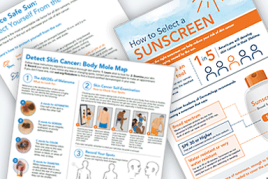Acne scars: How to care for your skin after treatment
After treating acne scars, gentle skin care is essential
Your dermatologist will explain how to care for your skin.

Proper aftercare plays an important role in helping you get the best results from treatment for acne scars. That’s why your dermatologist will give you individualized aftercare instructions. So that you know what to expect, here’s a look at what aftercare typically involves.
Follow your dermatologist’s aftercare instructions. This may include a skin care routine, which includes using certain skin care products. If your dermatologist recommended skin care products, use them. Your treated skin can be sensitive after treatment, and these products can help. Your dermatologist may also tell you to stop wearing makeup for a few days. Be sure to avoid wearing makeup until your dermatologist tells you it’s okay to use it.
Apply sunscreen every day to the treated skin. After treatment, the sun can darken treated skin. Wearing sunscreen helps prevent this. Even if you’re only going to be outside for a brief time like walking to your car, it’s essential to apply sunscreen 15 minutes before you go outdoors. To protect your skin from the sun, your sunscreen should offer:
- Broad-spectrum protection
- Water-resistance
- SPF 30 or higher
Avoid tanning and spending time in the sun. After treatment, your skin needs time to heal. In general, you’ll need to avoid spending too much time outdoors during the day for 6 to 8 weeks — even on cloudy or cool days.
Wash the treated skin as your dermatologist recommends. Keeping your skin clean helps reduce the risk of infection.
Have realistic expectations. While treatment can minimize the appearance of scars, it can take time to see results. Many treatments for depressed (sunken-in) scars help the skin to make more collagen and elastin, which reduces the sunk-in appearance. It takes time for your body to make collagen and elastin.
Your skin may also be swollen or discolored after treatment. This typically goes away in a few days.Return for all the treatments your dermatologist recommends. Treatment for acne scars is rarely one and done. You may need three or more treatments to get the best results.
Continue acne treatment as needed. If your skin is prone to breakouts, continue using your acne treatment. New acne breakouts could cause new acne scars. The best way to prevent this is to continue using your acne treatment. Acne treatment is designed to prevent new breakouts.
Your dermatologist can tell you when you can stop treating acne.
To find a board-certified dermatologist who can help you with acne scars, go to Find a Dermatologist.
Image
Getty Images
Written by:
Paula Ludmann, MS
Reviewed by:
Kesha Buster, MD, FAAD
Sandy Marchese Johnson, MD, FAAD
Desmond Shipp, MD, FAAD
Last updated: 12/8/23
 Atopic dermatitis: More FDA-approved treatments
Atopic dermatitis: More FDA-approved treatments
 Biosimilars: 14 FAQs
Biosimilars: 14 FAQs
 How to trim your nails
How to trim your nails
 Relieve uncontrollably itchy skin
Relieve uncontrollably itchy skin
 Fade dark spots
Fade dark spots
 Untreatable razor bumps or acne?
Untreatable razor bumps or acne?
 Tattoo removal
Tattoo removal
 Scar treatment
Scar treatment
 Free materials to help raise skin cancer awareness
Free materials to help raise skin cancer awareness
 Dermatologist-approved lesson plans, activities you can use
Dermatologist-approved lesson plans, activities you can use
 Find a Dermatologist
Find a Dermatologist
 What is a dermatologist?
What is a dermatologist?